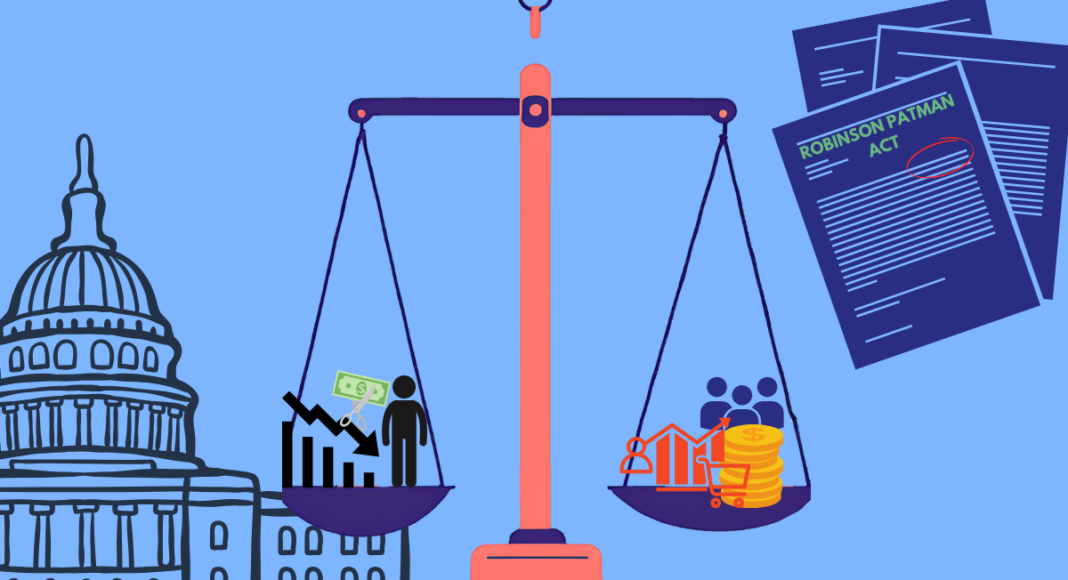Steven Salop explores the presumptions and evidence that could undergird Commissioner Melissa Holyoak’s preferred “Raising Rivals’ Cost” approach to the enforcement of the Robinson-Patman Act.
In the last month of the Biden administration, the Federal Trade Commission (FTC) issued two Robinson-Patman Act (RPA) complaints for price discrimination, one against a liquor wholesaler, Southern Glazer’s, and the other against PepsiCo. The Robinson-Patman Act was enacted in 1936 but has not seen use in decades. These two cases and the approach of the new Republican majority will may us a glimpse into whether the Act will ever make a comeback.
Both Republican commissioners dissented, Commissioner (now–Chairman) Andrew Ferguson stated his intent to enforce the “duly enacted law that Congress has repeatedly declined to repeal.” Commissioner Melissa Holyoak explained that “the Commission must faithfully execute the law” and wrote an 88–page dissent that detailed her view of the history of the RPA and the proper legal and economic approach.
Commissioner Holyoak specifically suggested that RPA enforcement of secondary line violations, where wholesalers give favored customers a price advantage over competing customers, must involve a rule of reason analysis based on the raising rivals’ cost (RRC) paradigm that arguably flows from the Clayton Act language in Section 2(a). In doing so, she expressed the view that enforcement must be based on consumer harm (i.e., harm to competition such as higher prices for goods to the final customer, not simply harm to competitors). In this reading, if price discrimination does not lead to higher prices to end consumers, there is no cognizable competitive harm. Herbert Hovenkamp, who has been a long-time critic of the RPA, also treats this as a possible way to “salvage” the RPA by amending it.
Friends have suggested that Commissioner Holyoak’s proposed RRC approach also is a personal invitation for me to spell out how this enforcement program might be implemented in a practical way. I begin with some basic economics and an example of a case in which the RRC approach could prohibit anticompetitive price discrimination. I then discuss the Clayton Act’s legal approach, including the key role of presumptions that conduct is anticompetitive. I then apply this economic and legal analysis to developing probative economic evidence, including anticompetitive presumptions that might be useful for enforcement guidelines and the courts. Finally, for those that view the RPA as unsalvageable, I suggest an alternative approach for countervailing such price discrimination by manufacturers with substantial market power over small retailers in a way that increases competition.
Basic economic analysis
It has always been clear that discriminatory prices charged to final consumers can sometimes lower consumer welfare and output but other times raise them. Indeed, in extreme cases, price discrimination may be necessary for a firm to cover its fixed costs.
The analysis is decidedly more complex for discriminatory prices charged to intermediaries such as retailers. This difference can be shown in a simple paradigmatic economic model roughly along the lines of a model in Michael Katz’s seminal article on price discrimination in intermediate goods markets.
First, suppose there is a chain store that operates in many cities and competes with local stores that sell in only a single city. Suppose that the chain store has constant marginal costs that are lower than the constant marginal costs of the local stores. Suppose that the stores are differentiated, which would lead to retail prices exceeding their marginal costs.
To analyze the potential for discrimination, assume there is a domestic manufacturer that is a monopolist over the local retailers. However, suppose that the chain store has the scale either to backward integrate into manufacturing itself or purchase in bulk from a lower-cost importer albeit at a price that exceeds the cost of the domestic manufacturer. This latter assumption is key. This is because in a conventional model of a monopolist manufacturer selling to retailers with different costs, the monopolist manufacturer would have the incentive to charge a discriminatory higher input price to the lower cost retailer. This is because the low-cost retailer has a higher willingness-to-pay, all else equal.
Absent non-discrimination constraints, the chain store’s ability and incentive to integrate or purchase imports at scale will give it the bargaining leverage to obtain a low price from the domestic manufacturer. The manufacturer nonetheless will have a power and incentive to charge higher prices to the differentiated local stores, constrained only by the fact that higher prices will cause them to lose some business to the chain store from which it earns a lower margin, where the rate of substitution will depend on the degree of retailer product differentiation.
Given these economic conditions, assume next that this price discrimination by the manufacturer becomes prohibited. In this situation, the chain store retains its overpowering ability and threat to buy elsewhere. Thus, if the manufacturer cannot discriminate by price, it likely will have the incentive to charge that same low price to the local stores rather than lose all the business of the chain store. As a result, the local stores’ costs and the retail prices of all the stores will fall, and output and consumer welfare will rise. By contrast, the discrimination would have raised rivals’ costs and also given the chain store the power to raise price.
This is not to say that the RRC approach to enforcement always leads to lower retail prices, let alone so perfectly. Price discrimination often lowers the price paid by the chain store while raising the prices paid by the disfavored local stores. These price adjustments could lead either to higher or lower retail prices, even when the chain store has the ability to integrate. However the paradigmatic example does have an important lesson. The greater is the chain store’s buyer-side bargaining power or leverage, the more likely it is that the non-discrimination rule will benefit the local stores, who can essentially get a free ride on that bargaining power. In this situation, there also is not an elimination of double marginalization benefit.
The economics literature not surprisingly contains other technical models with different results. For example, non-discrimination rules can act as a legal commitment device that prevents individual buyers from disrupting suppliers’ market power. In this situation, permitting discrimination can lead to lower prices for all buyers, as in the famous Coase Conjecture model. This procompetitive outcome is less likely to occur in an asymmetric market where one buyer has substantially greater bargaining power and leverage over the supplier.
However, this is not to reject the basic point that the economic literature overall suggests that the analysis of the effect on retail prices must be based on the facts of the market and probative economic evidence, as discussed below.
The Clayton Act, incipiency and anticompetitive presumptions
Commissioner Holyoak’s RRC approach to Section 2(a) is based on the language that price discrimination is proscribed “where the effect of such discrimination may be substantially to lessen competition or tend to create a monopoly in any line of commerce” under a RRC rule of reason approach (italics added). She rejects the interpretation of the addendum language (“or to injure, destroy, or prevent competition with any person who either grants or receives the benefit of such discrimination, or with customers of either of them”) as creating a per se rule.
Commissioner Holyoak also recognizes the meaning of the term “may be” is to specify an incipiency standard. As I have discussed elsewhere, the Clayton Act’s statutory language of “may be” (instead of “is”) was an intentional decision to create a lower burden on the plaintiff than the Sherman Act. The House and Senate conferees explicitly adopted a compromise language that changed the language from “is” to “may be.” Conferee Senator William Chilton explained this language to the Senate as follows: “That compromise was the adoption of the words ‘may be’ instead of the word ‘is,’ so that instead of reading ‘where the effect is’ the bill now reads, ‘where the effect may be’; that is, where it is possible for the effect to be….” Brown Shoe quotes the Senate report, stating that “The use of these words [‘may be’] means that the bill, if enacted, would not apply to the mere possibility, but only to the reasonable probability, of the prescribed [sic] effect.”
While incipiency has sometimes been characterized as stopping conduct before it gained anticompetitive momentum, the more modern interpretation (and the one consistent with Chilton’s interpretation) is to create a probabilistic standard, as expressed in Philadelphia National Bank as well as Brown Shoe.
This probabilistic incipiency standard also provides the rationale for developing and applying anticompetitive presumptions, just as it does for horizontal mergers. The traditional (and almost conclusive) anticompetitive presumption in Section 2(a) is the harm to a competitor from the price discrimination. However, this presumption has been highly criticized as leading to excessive false positives and over-deterrence, which suggests that the incipiency standard might better be served with different anticompetitive presumptions.
I next turn to potential evidence, beginning with evidence that can constitute a presumption that the discrimination is anticompetitive. This evidence would be useful for courts if the FTC decides to adopt the RRC approach or if the statute is amended do so. The evidence also will be useful for affected companies and FTC staff, if the FTC eliminates uncertainty by developing enforcement guidelines.
Anticompetitive presumptions supporting the RRC standard
While Commissioner Holyoak supported the incipiency standard, her analysis did not include discussion of possible anticompetitive presumptions when the RRC approach is adopted.However, as discussed above, such presumptions are consistent with the probabilistic interpretation of the incipiency standard as in Section 7 merger law. These anticompetitive presumptions are intended to be rebuttable, not conclusive. (For concreteness, I will discuss these presumptions and evidence in the context of a large chain store retailer obtaining a discriminatory low wholesale price from a wholesaler or a manufacturer selling directly to retailers).
- A wholesale contract that includes a favored-customer provision that entails a strictly lower price or otherwise promises that the chain store buyer will receive a substantially lower wholesale price than paid by its local retail competitors. Such provisions provide direct incentives for manufacturers to raise the wholesale prices of the disfavored local retailers rather than simply reducing the price charged to the chain store retailer and leaving the other retailers at the same level or also giving them lower prices. Indeed, this exclusionary incentive was recognized in Section 8 of the 2010 Horizontal Merger Guidelines.
- The chain store buyer receiving the lower wholesale price has (i) buyer-side dominant bargaining power over the supplier and (ii) seller-side market power in the retail market, while (iii) the supplier itself has substantial market power over the local retail competitors. These three facts make it more likely that the price discrimination will raise the costs of these disfavored retailers and lead to higher retail prices and reduced output.
Other probative evidence
There is a variety of direct and indirect probative economic evidence. This evidence can be used to replace, reinforce or rebut the anticompetitive presumptions.
- If a case is brought in response to recently instituted price discrimination, direct evidence would be the actual effect on retail prices—either an upward or downward effect.
However, that direct evidence may not be available, for example, if it is not clear when the discriminatory pricing was first instituted. In addition, other evidence can provide guidance to firms who wish to comply with the law. Other probative evidence could include the following:
- The market power of the wholesaler. If the chain store buyer obtains a discount from one wholesaler but there are other wholesalers with brands of the product that are close substitutes for the disfavored retailers, the loss of access to the wholesaler’s brand of the product is less likely to be competitively significant, even in a narrow retail market limited solely to that type of product. For example, if the chain store gains a large discount for one brand and there are other equally desirable and costly brands whose prices are unaffected, then harm to competition is unlikely. (This is analogous to the analysis of competitively insignificant foreclosure in a vertical merger.)
- The magnitude of the discriminatory price differential. If this differential is small, it is less likely to cause substantial harm to competition.
- Distributional cost-savings or other procompetitive justifications for the discriminatory lower price, such as those are flagged in the statute. These would include lower delivery costs or promised non-price services valued by consumers that the disfavored retailers would be unable or unwilling to provide.
- Comparison of the chain store’s retail margin for the product versus its margin earned other comparable products that lack discriminatory prices, which then can be used as a possible measure of the likely pass-through of the lower wholesale price on its retail price.
- Analysis of the buyer’s pass-through rates of previous costs increases. A low pass-through rate by the chain store buyer suggests a smaller retail price benefits from it obtaining a discount.
- The existence of competing chain stores obtaining similar discriminatory discounts and the intensity of competition among them. Evidence of intense competition among them suggests that the discounts will lead to lower retail prices for the product rather than rising retail prices.
The analysis of competition between the chain store receiving the discount and its local retail competitors can lead to some confusion. First, if the disfavored retailers are differentiated and only distant product or geographic competitors with the chain store buyer, the effect of the discrimination on wholesale prices differentials may be smaller. However, the disfavored stores’ customers will still be harmed by the higher discriminatory prices while the chain store’s customers will benefit from its lower discriminatory price so there still may be net competitive harm on balance. Indeed, the harmed consumers by themselves might comprise the relevant market. Second, it is important to recognize that a low collective market share of the disfavored retailers by itself does not mean that they are distant competitors. They may still provide a significant constraint on the ability of the chain store buyer to raise the retail price, as indicated in the standard economic models of limit pricing by a monopolist or dominant firm with a competitive fringe.
An alternative approach to combating discrimination by a powerful manufacturer
The Antitrust Modernization Commission in 2007 treated the RPA as beyond hope and recommended that it be repealed. An alternative approach to combating that price discrimination in a way that increases competition in the retail market would be to permit those disfavored small retailers to form associations that collectively bargain with the powerful wholesalers to negotiate their own discounts. In this way, they could more closely level the competitive playing field with their more powerful retail chain store competitors. Section 1 already permits buyer cooperatives if the associations also create other non-price procompetitive efficiencies. These retailer associations would have greater countervailing bargaining power if a legislative exemption (or an interpretation of Section 1 doctrine) would treat their moderate countervailing power by itself as sufficient to escape the per se rule and prevail under the rule of reason. In two articles (here and here), I have explained that this approach leads to increased competition in the retail market as well as benefiting the disfavored retailers.
Author Disclosure: Steve Salop is Professor of Economics and Law Emeritus, Georgetown University Law Center and Senior Consultant, Charles River Associates. He benefited from helpful comments from Laura Alexander, Daniel Francis, Herbert Hovenkamp and Aviv Nevo. He is not involved in any Robinson-Patman litigation.
Articles represent the opinions of their writers, not necessarily those of the University of Chicago, the Booth School of Business, or its faculty.






